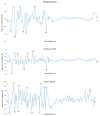Rapid Prediction of Nutrient Concentration in Citrus Leaves Using Vis-NIR Spectroscopy
- PMID: 37514824
- PMCID: PMC10386652
- DOI: 10.3390/s23146530
Rapid Prediction of Nutrient Concentration in Citrus Leaves Using Vis-NIR Spectroscopy
Abstract
The nutritional diagnosis of crops is carried out through costly foliar ionomic analysis in laboratories. However, spectroscopy is a sensing technique that could replace these destructive analyses for monitoring nutritional status. This work aimed to develop a calibration model to predict the foliar concentrations of macro and micronutrients in citrus plantations based on rapid non-destructive spectral measurements. To this end, 592 'Clementina de Nules' citrus leaves were collected during several months of growth. In these foliar samples, the spectral absorbance (430-1040 nm) was measured using a portable spectrometer, and the foliar ionomics was determined by emission spectrometry (ICP-OES) for macro and micronutrients, and the Kjeldahl method to quantify N. Models based on partial least squares regression (PLS-R) were calibrated to predict the content of macro and micronutrients in the leaves. The determination coefficients obtained in the model test were between 0.31 and 0.69, the highest values being found for P, K, and B (0.60, 0.63, and 0.69, respectively). Furthermore, the important P, K, and B wavelengths were evaluated using the weighted regression coefficients (BW) obtained from the PLS-R model. The results showed that the selected wavelengths were all in the visible region (430-750 nm) related to foliage pigments. The results indicate that this technique is promising for rapid and non-destructive foliar macro and micronutrient prediction.
Keywords: agricultural sensors; chemometrics; citrus nutrition; fertilisation; ionomics.
Conflict of interest statement
The authors declare no conflict of interest.
Figures
References
-
- Food and Agriculture Organization (FAO) Citrus Fruit. Fresh and Processed Statistical Bulletin 2020. Market and Trade Commodities. [(accessed on 7 July 2023)]. Available online: https://www.fao.org/markets-and-trade/commodities/citrus/en.
-
- United States Department of Agriculture (USDA) Citrus: World Market and Trade. Office of Global Analysis. Foreign Agriculture Service. [(accessed on 7 July 2023)]; Available online: https://www.fas.usda.gov/data/citrus-world-markets-and-trade.
-
- United States Department of Agriculture (USDA) Citrus Annual. Foreign Agricultural Service. [(accessed on 7 July 2023)]; Available online: https://apps.fas.usda.gov/newgainapi/api/Report/DownloadReportByFileName....
-
- Marschner P. Marschner’s Mineral Nutrition of Higher Plants. Elsevier; Amsterdam, The Netherlands: 2012. Rhizosphere Biology; pp. 369–388.
-
- Millard P. Ecophysiology of the Internal Cycling of Nitrogen for Tree Growth. Z. Pflanzenernahr. Bodenkd. 1996;159:1–10. doi: 10.1002/jpln.1996.3581590102. - DOI
MeSH terms
Substances
Grants and funding
LinkOut - more resources
Full Text Sources
Miscellaneous



